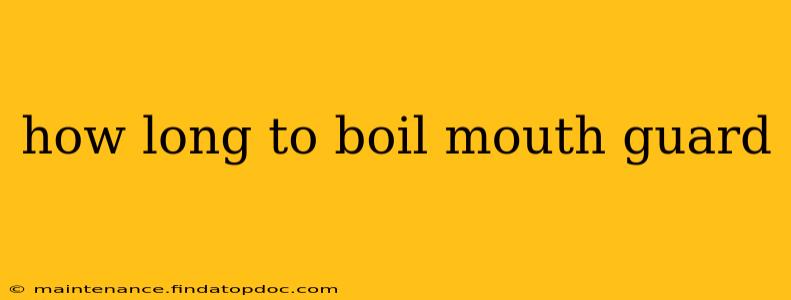Boiling a mouthguard is a common method for disinfecting and reshaping it. However, the boiling time is crucial to avoid damaging the material. This guide will explore the optimal boiling time, along with answers to frequently asked questions about this process.
How Long Should You Boil a Mouthguard?
The recommended boiling time for a mouthguard is between 1 to 2 minutes. Going beyond this time can significantly weaken the material, potentially making it brittle and less effective at protecting your teeth. It's better to err on the side of caution and stick to the shorter end of this timeframe.
The type of mouthguard material also plays a role. For example, some boil-and-bite mouthguards might require slightly longer boiling times as indicated by the manufacturer's instructions. Always refer to the specific instructions provided with your mouthguard. These instructions are crucial for ensuring the proper disinfection and reshaping process without compromising the integrity of the guard.
What Happens if You Boil a Mouthguard Too Long?
Boiling a mouthguard for too long can cause several problems:
- Warping: Excessive heat can cause the mouthguard to warp or lose its shape, rendering it less effective at protecting your teeth.
- Brittleness: Prolonged boiling can make the material brittle, increasing the risk of breakage during use.
- Discoloration: The heat can also cause discoloration of the mouthguard.
What Happens if You Don't Boil a Mouthguard Long Enough?
Boiling a mouthguard for too short a time may not effectively disinfect it, leaving bacteria and germs on the surface. This could lead to oral infections or other health issues. While not as problematic as over-boiling, insufficient boiling is still something to avoid.
Can I Boil a Custom-Fit Mouthguard?
Generally, it's not recommended to boil a custom-fit mouthguard. Custom-made mouthguards are often crafted from more delicate materials compared to boil-and-bite guards. Boiling them might damage their structure or alter their fit. If your custom-fit mouthguard needs cleaning or disinfecting, consult with your dentist or the manufacturer for appropriate cleaning methods.
How to Properly Boil a Mouthguard: A Step-by-Step Guide
- Fill a pot with water: Use enough water to completely submerge the mouthguard.
- Bring the water to a rolling boil: Make sure the water is at a vigorous boil before adding the mouthguard.
- Submerge the mouthguard: Carefully place the mouthguard in the boiling water.
- Boil for 1-2 minutes: Time this carefully using a timer.
- Remove the mouthguard: Use tongs or a similar utensil to remove the mouthguard from the water. Avoid touching the hot mouthguard with your bare hands.
- Rinse with cool water: Allow the mouthguard to cool slightly before rinsing it thoroughly with cool water.
- Air dry: Allow the mouthguard to air dry completely before using it again. Do not use a towel as this can introduce bacteria.
Alternative Methods for Cleaning a Mouthguard
Boiling isn't the only way to clean a mouthguard. You can also:
- Use mouthwash: Rinse the mouthguard with an antimicrobial mouthwash.
- Use a toothbrush and soap: Gently brush the mouthguard with a toothbrush and mild soap. Rinse thoroughly afterwards.
Remember to always follow the manufacturer's instructions provided with your mouthguard. If you have any doubts about the best cleaning method for your specific mouthguard, consult with your dentist. Maintaining the cleanliness and integrity of your mouthguard is essential for your oral health.
